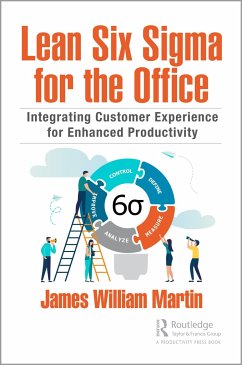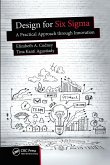James William Martin (Six Sigma Integration, Inc., Rehoboth, Massac
Lean Six Sigma for the Office
Integrating Customer Experience for Enhanced Productivity
James William Martin (Six Sigma Integration, Inc., Rehoboth, Massac
Lean Six Sigma for the Office
Integrating Customer Experience for Enhanced Productivity
- Gebundenes Buch
- Merkliste
- Auf die Merkliste
- Bewerten Bewerten
- Teilen
- Produkt teilen
- Produkterinnerung
- Produkterinnerung
Historically, the integration of manufacturing methodologies into the office environment has proven to be problematic. Part of the difficulty lies in the fact that process workflows tend to be globally dispersed and thus rely heavily on information technology.
Andere Kunden interessierten sich auch für
![Operational Excellence Operational Excellence]() James MartinOperational Excellence67,99 €
James MartinOperational Excellence67,99 €![The Lean Six Sigma Black Belt Handbook The Lean Six Sigma Black Belt Handbook]() Frank VoehlThe Lean Six Sigma Black Belt Handbook87,99 €
Frank VoehlThe Lean Six Sigma Black Belt Handbook87,99 €![The Lean 3P Advantage The Lean 3P Advantage]() Allan R. ColettaThe Lean 3P Advantage51,99 €
Allan R. ColettaThe Lean 3P Advantage51,99 €![Always Making Progress Always Making Progress]() Ian MaddenAlways Making Progress133,99 €
Ian MaddenAlways Making Progress133,99 €![Design for Six Sigma Design for Six Sigma]() Elizabeth A. CudneyDesign for Six Sigma53,99 €
Elizabeth A. CudneyDesign for Six Sigma53,99 €![Leveraging Digital Mixed Model Value Stream Maps Leveraging Digital Mixed Model Value Stream Maps]() Girish HidaduggiLeveraging Digital Mixed Model Value Stream Maps68,99 €
Girish HidaduggiLeveraging Digital Mixed Model Value Stream Maps68,99 €![Made-to-Order Lean Made-to-Order Lean]() Greg Lane (Low Volume Lean, Stockton, CA, USA)Made-to-Order Lean57,99 €
Greg Lane (Low Volume Lean, Stockton, CA, USA)Made-to-Order Lean57,99 €-
-
-
Historically, the integration of manufacturing methodologies into the office environment has proven to be problematic. Part of the difficulty lies in the fact that process workflows tend to be globally dispersed and thus rely heavily on information technology.
Produktdetails
- Produktdetails
- Verlag: Taylor & Francis Ltd
- 2 ed
- Seitenzahl: 374
- Erscheinungstermin: 23. März 2021
- Englisch
- Abmessung: 235mm x 157mm x 25mm
- Gewicht: 698g
- ISBN-13: 9780367503277
- ISBN-10: 0367503271
- Artikelnr.: 60595959
- Herstellerkennzeichnung
- Libri GmbH
- Europaallee 1
- 36244 Bad Hersfeld
- gpsr@libri.de
- Verlag: Taylor & Francis Ltd
- 2 ed
- Seitenzahl: 374
- Erscheinungstermin: 23. März 2021
- Englisch
- Abmessung: 235mm x 157mm x 25mm
- Gewicht: 698g
- ISBN-13: 9780367503277
- ISBN-10: 0367503271
- Artikelnr.: 60595959
- Herstellerkennzeichnung
- Libri GmbH
- Europaallee 1
- 36244 Bad Hersfeld
- gpsr@libri.de
James William Martin is a Lean Six Sigma consultant and Master Black Belt for 25 years and has trained and mentored several thousand executives, champions, Black Belts, and Green Belts in process improvement methods including manufacturing, services, and supply chain applications. He led successful Lean Six Sigma assessments across Japan, China, Korea, Singapore, Malaysia, Th ailand, Australia, North America, and Europe. Th is work included organizations in hardware, soft ware, computer security, retail sales, banking, insurance, fi nancial services, measurement systems, automotive, electronics, aerospace component manufacturing, electronic manufacturing, controls, building products, industrial equipment, and consumer products. He served as an instructor at the Providence College Graduate School of Business for 20 years. He holds an MS in Mechanical Engineering, Northeastern University; an MBA, Providence College; a BS, Industrial Engineering, University of Rhode Island; several patents; and he has written numerous articles on process improvement.
Contents
Introduction
.........................................................................................
xiii
About the Author
..............................................................................
xxvii
STEP 1 Align Improvement Opportunities
Chapter 1 Strategy Alignment
............................................................. 3
Chapter 2 Project Identification
....................................................... 51
Chapter 3 Lean Six Sigma Basics
...................................................... 83
STEP 2 Plan and Conduct the Rapid Improvement Event
Chapter 4 Rapid Improvement Events
............................................ 135
Chapter 5 Data Collection and Analysis
........................................ 167
Chapter 6 Process Improvement
..................................................... 225
STEP 3 Implementing Solutions
Chapter 7 Building a Case for Change
........................................... 259
Chapter 8 Implementing Solutions
................................................. 277
Chapter 9 Organizational Change
.................................................. 303
Index
....................................................................................................
339
Introduction
.........................................................................................
xiii
About the Author
..............................................................................
xxvii
STEP 1 Align Improvement Opportunities
Chapter 1 Strategy Alignment
............................................................. 3
Chapter 2 Project Identification
....................................................... 51
Chapter 3 Lean Six Sigma Basics
...................................................... 83
STEP 2 Plan and Conduct the Rapid Improvement Event
Chapter 4 Rapid Improvement Events
............................................ 135
Chapter 5 Data Collection and Analysis
........................................ 167
Chapter 6 Process Improvement
..................................................... 225
STEP 3 Implementing Solutions
Chapter 7 Building a Case for Change
........................................... 259
Chapter 8 Implementing Solutions
................................................. 277
Chapter 9 Organizational Change
.................................................. 303
Index
....................................................................................................
339
Contents
Introduction
.........................................................................................
xiii
About the Author
..............................................................................
xxvii
STEP 1 Align Improvement Opportunities
Chapter 1 Strategy Alignment
............................................................. 3
Chapter 2 Project Identification
....................................................... 51
Chapter 3 Lean Six Sigma Basics
...................................................... 83
STEP 2 Plan and Conduct the Rapid Improvement Event
Chapter 4 Rapid Improvement Events
............................................ 135
Chapter 5 Data Collection and Analysis
........................................ 167
Chapter 6 Process Improvement
..................................................... 225
STEP 3 Implementing Solutions
Chapter 7 Building a Case for Change
........................................... 259
Chapter 8 Implementing Solutions
................................................. 277
Chapter 9 Organizational Change
.................................................. 303
Index
....................................................................................................
339
Introduction
.........................................................................................
xiii
About the Author
..............................................................................
xxvii
STEP 1 Align Improvement Opportunities
Chapter 1 Strategy Alignment
............................................................. 3
Chapter 2 Project Identification
....................................................... 51
Chapter 3 Lean Six Sigma Basics
...................................................... 83
STEP 2 Plan and Conduct the Rapid Improvement Event
Chapter 4 Rapid Improvement Events
............................................ 135
Chapter 5 Data Collection and Analysis
........................................ 167
Chapter 6 Process Improvement
..................................................... 225
STEP 3 Implementing Solutions
Chapter 7 Building a Case for Change
........................................... 259
Chapter 8 Implementing Solutions
................................................. 277
Chapter 9 Organizational Change
.................................................. 303
Index
....................................................................................................
339








